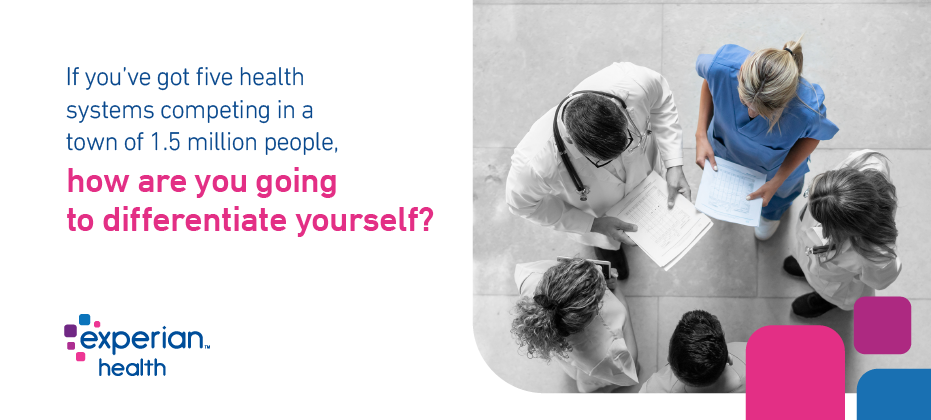Data and Analytics
Capturing the right data and turning it into actionable insights will improve revenue cycle, patient outreach, and marketing strategies.

With a vaccine for COVID-19 thought to be at least a year away, healthcare providers are steeling themselves for even more cases in the fall. The big worry is that a surge in cases will hit the health system just as flu season takes hold. In a recent interview, Dr. Robert Redfield, Director of the Centers for Disease Control and Prevention (CDC), warned that “the assault of the virus on our nation next winter [may] actually be even more difficult than the one we just went through… we’re going to have the flu epidemic and the coronavirus epidemic at the same time.” Healthcare organizations are accustomed to an influx of sick patients between October and March: around 62,000 people died and more than 700,000 were hospitalized during last winter’s flu season. With 130,000 Americans losing their lives to COVID-19 in just four months, what could happen when the two respiratory diseases collide? Large numbers of patients with either virus (or potentially with both) will put renewed pressure on staff and services that are already under immense strain. Hospitals will need to prepare to manage both groups of patients as efficiently and safely as possible. Five ways to ease stress, paperwork and patient concerns ahead of a dual epidemic 1. Use data to drive your patient engagement strategy Create a flu preparedness patient engagement strategy to keep patients informed of how best to protect themselves in the context of a dual epidemic. As a result of the coronavirus pandemic, patients may be more familiar with telehealth services as a “contact-free” alternative to in-person appointments, so you’ll want to continue to promote these to minimize the spread of infection. With consumer data, you can segment patients according to risk and automate your communications, so they get the most relevant message at the most convenient time. 2. Relieve pressure on staff with automated patient scheduling Digital scheduling gives patients the option to book appointments online, at a time and place that suits them. This reduces pressure on call center staff and can give providers control over the volume and timing of in-person appointments, thus helping to reduce the spread of germs. An online patient scheduling platform can automate the entire scheduling process, integrating in real-time with your records management systems and connecting to your referral providers’ systems for a seamless patient and staff experience. 3. Screen patients proactively to discover their needs ahead of time Asking patients to fill out electronic questionnaires before their visit means their access needs can be identified and addressed before they come in. Do they need help to find transportation? Will they face any challenges in picking up a prescription? Is there something that could stand in the way of follow-up care? Screening for social determinants of health can answer these questions so you can direct patients to the most appropriate care and support. 4. Enable digital patient registration for a quick and easy intake experience Speed up the registration process by giving patients the option to complete their intake admin by phone or through their patient portal. Not only will this reduce the spread of infection in busy waiting rooms, it’ll make for a more enjoyable patient experience and free up limited staff resources for other priorities. With automated registration and consumer-facing mobile experiences, you can improve the patient experience, operational efficiencies and data accuracy all at the same time. 5. Minimize in-person interactions with contactless payments Encourage patients to clear their balances without having to hand over cash or access payment kiosks. Self-service digital payment tools allow patients to make contactless payments through their patient portal or from their mobile device. “The combined pressure from two viruses hitting health systems at once means it’s even more important for providers to leverage data for speed and accuracy. Automated workflows can help accelerate operational efficiency, as well as create a better patient experience during what’s already an extremely stressful time.” Victoria Dames, Vice President of Product Management for Experian Health Find out more about how Experian Health’s expertise in data and analytics can help your organization prepare for the coming flu season so you can offer your patients a safe, accessible and stress-free experience. We have also developed a checklist of action items for providers to consider as you prepare for both flu and COVID-19. How ready are you? Which actions is your organization instituting now?

By January 2021, millions of those who suffered job losses in the wake of COVID-19 will see their unemployment insurance end. Medicaid and subsidized coverage under the Affordable Care Act (ACA) will be a safety net for many, but nearly 2 million Americans could find themselves stuck in the ‘coverage gap’, where their household income exceeds the eligibility threshold for Medicaid, yet falls below the lower limit required to receive ACA marketplace subsidies. Without large group or government coverage, these consumers will be left uninsured or forced to purchase individual plans with high deductibles. Considering this will likely contribute to larger patient balances and more struggles with patient collections, many are bracing for a hit to their bottom line. To help minimize accounts receivable and avoid bad debt write-offs, choosing the right data model should be a top priority. Here, we look at one piece that’s often missing from the patient collections puzzle: credit data. Don’t overlook credit data in your self-pay collections strategy Many providers already use demographic and behavioral data to power patient collections, but there can be gaps in what’s known about a consumer’s ability to pay. Credit data can help fill in the blanks. Here are three ways this can be used to optimize your collections strategy: 1. Get a complete view of your patients’ financial situation for faster decision-making Credit data can reveal how a patient is managing other financial obligations, giving you insights about how to handle their healthcare account for a greater chance of payment. Have they just maxed out a credit card? Have they missed a student loan payment or fallen behind on their mortgage? If so, they’re probably going to find it difficult to pay off their medical bill. Knowing this, you can move quickly to help them find alternative coverage or offer a more manageable payment plan. Conversely, if they’ve just bought a new car or paid off a personal loan, there’s a high chance they’re in a good position to pay their medical bills too, so contacting them with a straightforward and easy payment plan means they can clear their balance promptly. 2. Segment patient accounts and allocate them to the right payment pathway The sooner you can get patients onto the right payment pathway, the more robust your cashflow will be. Credit data can help you segment accounts quickly and accurately. Experian Health data shows that when patients are segmented according to propensity to pay, collections increase by around 2% when credit data is included, compared to segmentation without credit data. Novant Health used Collections Optimization Manager to segment patients and check for available charity support or Medicaid eligibility. By getting patients on the right pathway and making sure agencies were focusing on the right accounts, they increased recovery rates by 5% and saw a rolling average return on investment of 8.5:1. 3. Create a more compassionate patient financial experience Using credit data also helps create a more compassionate patient financial experience. Instead of adding to a patient’s financial worries by chasing payments they’ll never be able to cover, you can run charity checks to see if there’s any missed coverage and quickly connect them to the right financial assistance program. A tool such as Collections Optimization Manager lets you segment patients based on their individual circumstances, for a more patient-friendly approach to collections. You can then personalize their communications and payment options so they can manage their expenses with less anxiety and more confidence. Discover why 60% of US hospitals are already using Experian Health’s advanced collections software and unrivaled datasets to optimize patient collections, and find out how we can help you build a resilient revenue cycle as self-pay accounts continue to rise.

Medical expenses are often a source of anxiety for many patients, whether they are unsure about the amount owed or how they’ll ultimately pay for it. Unfortunately, intimidating collections processes don’t help, and a crisis like COVID-19 only exacerbates this stress. A more compassionate billing approach could help patients better navigate their financial obligations and also build long-term loyalty—a necessity for providers today looking to retain patient volume during a time of crisis. Consumers overwhelmingly want to understand the cost of healthcare services, prior to services being performed. Effective price transparency involves offering patients clear, accessible, and easy-to-understand estimates of their financial responsibility for services before they are performed. Give patients clarity from the start with precise pricing estimates and up-front info about what they’ll have to pay can reduce sticker shock, help them plan and create an overall better patient financial experience. By empowering your patients with financial expectations, their feeling of control increases, improving their engagement and the likelihood that you will collect payments faster and more efficiently. Just as you don’t provide identical medical treatment to every patient, processing all patient accounts the same way doesn’t make sense. Every patient is different. Using comprehensive data and advanced analytics, providers can better understand an individual's propensity to pay and make the payment process a positive one by assessing and assigning each patient to the appropriate financial pathway based on their unique financial situation. Medical bills are often the most direct contact providers have with patients after a service is rendered. Unfortunately, money is often a sensitive topic for patients and statements are often overwhelming and difficult for patients to read. Tailoring communications at each stage can convey compassion and increase patient satisfaction. Customizing patient statements gives providers the ability to simplify and customize bills quickly and easily, turning an often confusing process into one that adds value. Including relevant, personalized messages and educational updates can turn billing statements into a useful resource, all with the potential to drive revenue. In addition to offering personalized payment options, providers can also find out whether a patient prefers to discuss billing by phone or email. Minimizing friction at the point of payment is crucial to fostering compassionate collections. Providers should offer flexible options that include in-person, telephone, mobile and online patient portals, so they can pay in a way that’s most convenient for them. This also frees up staff to help those patients who may need a little extra help understanding their statement. Want to learn more? Check out Experian Health’s Collections Optimization Manager which helps providers segment patients based on an individual’s propensity to pay and payment preferences, informing a compassionate patient engagement strategy and improving collections.

During this time when the whole world is wrestling with the Covid-19 crisis, planning for the future is difficult. However, there is no question that as the nation emerges from its stay-at-home status, there will be huge release of pent-up demand – especially for healthcare. Health systems have streamlined their operations to deal with the influx of COVID-19 testing and treatments. As a result, any non-emergent care or care unrelated to COVID-19 has been heavily gated, if not canceled entirely. This of course includes preventative care, non-critical regular screenings, and other services related to care gaps. Once the patient flow moves out of crisis mode, these services will certainly resume – and they will resume in earnest. This increased demand for services, coupled with the time lost to meet quality metrics, will place a real burden on member services and quality teams as they work to ensure missed preventative care, screenings, and other care related to care gaps are being sought and coordinated. It is possible to make small moves now to strategically prepare for what’s coming, so that when the crisis subsides organizations can be well positioned to serve their members. Here are a few key things payers can do to get ready: Get your data and strategy in order - Now is the time to use data to better understand your members and fill in any gaps you may have. For example, it is going to be essential to understand geographies and associated provider groups where care gap non-compliance is likely to be highest, so you can strategically focus on those areas. Also, understanding what the best channel of communication is and ensuring that you have accurate contact info for those members is critical. Fundamentally, plans will need data that can help them identify who to target and can supply needed, accurate contact info.Understand your members' SDOH barriers – Understanding your members' social determinants of health (SDOH) barriers will be more important than ever. One of the unfortunate byproducts of this COVID-19 crisis is the economic damage. As a result, there will undoubtedly be critical gaps, like transportation, that will affect your members' ability to access care and thus need to be accounted for. Likewise, with the downturn in the economy, additional social determinants will be on the rise, like food insecurity, housing insecurity, and access to medications. These should also factor into your overall plan – and thankfully there are increasing ways to identify and track SDOH.Implement digital tools now – Ensure your member engagement strategy is fully informed and your teams are ready to efficiently execute. While data can round out any information gaps that may exist for you – contact info, SDOH gaps, etc. – tools that can provide quick, convenient access to services will be needed to take action. For example, enabling your member engagement team with a digital scheduling platform that allows them to book appointments with providers without calling the provider, is a proven way to accelerate member engagement and close gaps in care. This type of digital engagement not only provides an efficiency gain, it also greatly improves the member experience as call times are shorter and members are given greater access to care. In times like this current pandemic it can be hard to think about much else beyond the here and now, and especially hard to picture a brighter future. But prudence would dictate that taking a little time now to prepare can make a big difference when things do start to open back up. Find out more about data driven solutions for member engagement.

With Google’s acquisition of Fitbit in November 2019 and Apple’s recent foray into smartphone-based clinical research, the ‘big four’ tech giants are ramping up their efforts to take a slice of the $3.6 trillion healthcare industry pie. These investments aren’t new. Between 2013 and 2017, Apple, Microsoft and Google’s parent company, Alphabet, filed a combined 300 health-related patents, while Amazon has been looking to expand into the pharmacy space since the early 2000s. Historically, it hasn’t been easy for new players to get into the healthcare game. Up to now, tech companies have mostly stayed in their lanes, using their expertise in cloud-based computing, artificial intelligence and supply chain management to break into health markets around the edges. What gives them a big advantage now is the rise of healthcare consumerism, especially in the digital realm. Patients expect to be treated as individuals, with communications and services that are convenient and tailored to their needs. The personalization that so delights them is powered by their own health data and a focus on the consumer experience – two of the tech companies’ biggest strengths. Providing a consumer-centric experience has been challenging for the healthcare industry. In fact, it’s been challenging for many legacy industries (banking, insurance, etc.). Amazon and others have a head start in being able to leverage vast quantities of consumer data and turn insights about their customers’ lifestyles, behaviors and preferences into a better consumer experience. How can healthcare providers compete? Understanding consumer data is key to a better patient experience and better population health The buzz around consumer data opportunities isn’t limited to the tech world. Recognizing the role of consumer data in improving both the patient experience and population health, more health systems are investing heavily in data analytics, looking at how they use data to market to their consumers and address the social determinants of health. Mindy Pankoke, Senior Product Manager for Experian Health, says: “Consumer data is becoming more important in healthcare because patients are people. They're more than a clinical chart or claims form. They have lifestyles, they have interests, they have behaviors. This is called consumer data. ‘Social determinants of health’ has become a huge buzzword in the healthcare industry and it's more than buzz. It's data about people's lifestyles that we can use to improve their health.” Over 80% of health outcomes are attributed to the social determinants of health, so knowing who your patients are and what they need is increasingly important if you want to improve their wellbeing. When you understand what’s going on in your patients’ lives, you’ll know whether they need assistance with transportation, understanding their healthcare information, managing a care plan or accessing healthy food. You can communicate with them in the most effective way and point them towards services that could help them access care and avoid more serious conditions. And even better, much of this can be done through time-saving automation tools. Where to start with consumer data Today’s leading healthcare providers are using consumer data in three main areas: 1. Streamlining patient communications Whether a patient is getting treatment for a broken leg or multiple chronic conditions, their healthcare journey probably involves hundreds of touchpoints with your organization. Consumer data helps you cut to the chase and give them the exact information they need to make their next decision or complete their next task, in the most convenient way. Data analytics allow you to create a slicker patient experience, by giving the right message in the right format – whether that’s in marketing to new patients, sending bill reminders, or encouraging wellness checks. 2. Segmenting patients according to social determinants of health In a study of 78 social needs programs published this month, Health Affairs reported that health systems invested more than $2.5 billion in interventions focused on housing, employment, education, food security, community and transportation, between 2017-2019. Clearly, some patients will benefit from these services, while others won’t. There’s no point giving the same information to every patient. Consumer data lets you segment your patient population and target information about social programs to the ones who need them most. 3. Creating bespoke services for your specific patient population Consumer insights tell you exactly what’s blocking your particular patient population from accessing care, now and in the future. You’ll know how many have difficulty attending appointments, how many might struggle to read complicated instructions and how many will be too busy to download and use your new healthy recipe app. Analyzing your population’s needs and tendencies allows you to predict future demand for different services and develop interventions to solve those specific challenges. Future-proof your consumer data strategy by working with a trusted partner As the big tech companies are coming to discover, healthcare data regulations are complex. You need to know where your data comes from, for the sake of both accuracy and permissibility. Working with a trusted data vendor in the health space can help ensure the reliability and integrity of your data, as they will have expertise in the appropriate use of consumer data in healthcare. They’ll help you pull insights from only the most relevant, current data, so you can build a competitive consumer experience on the strongest foundations. Find out more about how Experian Health’s consumer data analytics can give you a holistic view of your patients and the social determinants that affect their health.

Before brands like Apple and Amazon became synonymous with consumer culture, the healthcare experience didn’t have much motivation to change. If you felt ill, you’d go see a doctor. The doctor would check you over, make a diagnosis and set you on the appropriate path to treatment. It was on you to initiate contact: your physician’s only job was to provide whatever care was needed, once you were in the system. Today, the healthcare journey can look quite different. Patients have options. In an increasingly crowded market, it’s now up to providers to reach out and woo healthcare consumers. To stay ahead of the competition, providers must seek innovative ways to attract new consumers and inspire loyalty among existing members. Chris Wild, Experian Health’s Senior Director of Consumer Engagement Solutions, says: “Health systems have started taking a good, hard look at how they engage with patients, whether that’s marketing to new populations or encouraging patients to come in when they are sick. It all comes down to data. With a complete picture of the patient, you can loop together clinical information with insights about their lifestyle and attitudes, so you really know who they are and what they’ll need from your health system.” Three ways consumer data can help you attract and retain patients Data-driven marketing and engagement is a growing opportunity for providers. With the right data platform, it’s easier than ever to leverage reliable, high-quality data and analytics to better understand and serve your patients. In fact, Wild suggests there are three main ways marketing data can benefit healthcare providers (you can watch Wild talk about these on video): 1. Marketing to new and existing members Why should prospective patients choose your hospital or physician’s practice? What would prevent existing patients from being tempted to switch providers? Understanding what makes your patients tick lets you pinpoint the exact benefits, priorities and language that will resonate with them most. As Wild says: “If you’ve got five health systems competing in a town of 1.5 million people, how are you going to differentiate yourself? Once a patient picks up a provider and they’re relatively satisfied, they don’t change a lot. They’re starting to look at things like quality. They’re starting to look at cost and what’ll give them the biggest bang for their buck, but getting to them first is a big first-mover advantage for sure.” ConsumerView bundles up reliable information on around 500 demographic, psychographic and behavioral attributes to help you get to know your target market, so you can get the right message in front of them at the right time. 2. Engaging with patients to improve health outcomes Even if you’re the only health system in town, there’s still a need to engage. You want your patients to achieve the best possible health outcomes and often that requires them to take ownership of their health. You can help them do that by encouraging them to come in when they are sick, or by pointing them toward services that could make it easier for them to access care. To do this effectively, you need to know what your patients need. ConsumerView has around 1500 verifiable data points on 300 million US consumers, covering about 98% of the US population. These can be used to discover how your patients think about their health and how they make their buying decisions. When that’s merged with your own information about their clinical journeys, you can give them a truly personalized healthcare experience. 3. Future-proofing your services Finally, you can use these analytics to better understand your current patient population to make smarter decisions about the investments you need to make in future. Where are the bottlenecks in the patient’s healthcare journey? Where should you put new services? Robust data analytics help you say, “we need to invest here and this is why.” Wild says, “I’m working with one analytics team that’s looking to better understand where they’re going to allocate physical and human resources so they can follow up with their patients more completely. They’re digging in deep to understand what their current patient population looks like, and then using that data to understand what their future population may look like.” Data analytics helps you predict demand for services, so you can direct resources accordingly. You’ll be able to identify trends in patient pathways, so you can engage with patients earlier and make sure they get prompt care and support, giving them a better chance of a good outcome and saving your organization time and resources. Learn more about how your organization can drive marketing results through customer segmentation, targeted messaging and analytics

Did you know a whopping 90% of missed revenue opportunities can be linked to denied claims? At a time when providers are working to make up this lost revenue, they are also dealing with patients who are expected to cover more of their medical bills through out-of-pocket expenses. High-deductible health plans, free-care programs and crowdfunding are more prominent, leaving hospitals vulnerable to the patient’s ability to pay. Add in the rise of value-based care, and it’s no secret patients expect an experience that matches their interactions with other consumer services. They’re more engaged in their health and know they have options. Patient collections are down, but expectations are up. Loyalty wavers somewhere in the middle. How should providers respond? Legacy revenue systems aren’t set up for financial models based on value over volume, so providers need to adapt. It’s vital to find ways to help patients navigate the financial side of healthcare and make patient collection processes as efficient as possible. What does value-based care mean for your revenue cycle? Shifting to value-based reimbursements, patient-centric incentives and quality of care programs means your clinical and revenue cycle workflows need to be better connected. Patients must receive consistent and accurate communications throughout their healthcare journey, setting them up for the best possible health outcome and payment options. When the care and finance functions work together, your patient records can be kept up to date and the next admin task will be triggered at the right time. Here are some things your revenue cycle management (RCM) process might be missing: clear and convenient processes for patientsaccurate patient identification from registration to billingability to collaborate with payers to customize workflowsstreamlined workflows to reduce time and resources spent on avoidable tasksautomated processes to support effective collections and spot root causes of denialsreal-time reporting to help improve performance over time [Source: Frost and Sullivan] Data, analytics and automation can help you create more agile processes to minimize revenue leakage and create a better financial experience for patients. 3 ways to close the gaps in a value-based RCM model 1. Use consumer data to help patients make informed decisions A major cause of denied claims stems from patients being unsure about what their treatment will cost. Others are unclear about whether they have appropriate coverage. Help your patients weigh their financial options by providing accurate estimates and working with them to check coverage. Consumer data can support this process by giving you insights into your patient’s social identity, medical history, coverage status, insurance eligibility and propensity to pay. With an intuitive billing process, you’ll improve the patient payment experience and reduce revenue leakage. 2. Use analytics to predict gaps in your revenue cycle Many top-performing health systems use advanced data analytics to predict where the bottlenecks, errors and denials might creep in, so they can take swift action to address them and keep their patients and C-suite happy. For example, with analytics, you can get to know your patients better so you can segment them according to their financial responsibility and ability to pay. Not only does this mean you can focus your collections efforts more effectively, but you’ll have the right insights to help patients navigate the payment process with personalized nudges and relevant messaging. In addition, analytics have a huge role to play in eliminating avoidable denials resulting from unreliable or inaccurate patient data. You’ll be able to spot patterns in denials, so you can implement checks and processes to avoid them in future. 3. Put the right tools in place to close the gaps Close the widening gap between claims and collections starts by ensuring your patients are aware of their financial responsibility. A self-service patient portal could give your patients convenient access to their information in a time and place that suits them. They’ll be able to schedule appointments, enroll in payment plans, and apply for charity. They’ll see real-time, transparent and accurate information about price estimates and their eligibility and coverage. When the financial experience is transparent and frictionless, patients are more likely to feel satisfied and less likely to shop around for care – not to mention being better prepared to meet payment deadlines. And internally, data-driven automated software can help you monitor and manage every step of your revenue cycle. You can make life easier for clinicians and management teams with EHR-integrated dashboards, web-based financial reporting and timely alerts for the relevant teams. Schneck Medical Center used Experian Health’s Denials Workflow Manager to automate tedious manual processes, freeing up staff time and optimizing claims follow-up and collection: “No longer are we waiting 30 to 45 days to review denials. We can review them on the day of [submitting] if we choose to.” (McKenzie Smith, Director of Patient Financial Services) It’s simply no longer viable to use RCM processes that aren’t integrated across your entire digital ecosystem. Providers that can offer a convenient and personalized consumer experience, automate collections workflows and join the dots between clinical care and revenue management will have the competitive advantage in the era of value-based care. Learn more about how your organization can use data to predict and close gaps in your revenue cycle.

Recently I had the opportunity to present at a regional chapter of the National Association of Healthcare Access Management about the growing need for business intelligence to improve patient access functions, as well as revenue. In speaking with attendees, it became clear that automating the patient access workflow with real-time data can create a more efficient and accurate process. Here’s how. As the responsibility for paying healthcare bills increasingly falls to patients themselves, patient access can make or break the revenue cycle. From registration and verifying insurance details, to scheduling appointments and collecting cash payments—this is the front line for the financial side of the patient experience. When you consider that half of denied claims occur earlier in the revenue cycle at the point of registration, improving those early-stage patient access processes is the obvious place for providers to look when seeking to minimize lost revenue. Revenue loss in patient access is mostly due to errors in patient identification, inadequate data analytics and inefficient workflows. If front and back office teams were better connected and able to work together quickly to communicate and resolve issues, many of these errors could be prevented. Without reliable tools and workflows to support this, those teams often must resort to manual fixes for any errors that arise. Unfortunately, this takes time and effort, blocking opportunities to find new ways to improve decision making and business performance. Healthcare is becoming more competitive. Providers must work to leverage the right data in the right way to safeguard profits and offer a better patient experience. That said, where should you start? Doing more with less requires the right data insights There are two sides to the solution: first, you need to be sure your data is accurate from the start. Around a third of denied claims are caused by inaccurate patient identification, while 12% of patient records are duplicates. Cleaning up your data with high-quality demographic data can help eliminate preventable denials. Secondly, you need to be able to draw insights from your data to help make smarter decisions in the future. Let’s say you notice a spike in late payments from a certain population. Why is that? Looking at historical data on patient and payer behavior can point to emerging trends and help you figure out where to focus your efforts in response. Or perhaps you’ve recently added a new function to your patient portal. Analytics can help you see if and how patients are using it and evaluate its overall performance. Once you have your data and analytics in place, you can start to use it to make improvements. Automating the patient access workflow with real-time data can create a more efficient and accurate process. It will also help link front and back office staff with shared systems that minimize errors and wasted staff time. 3 ways to use data analytics to streamline patient access For providers looking to streamline their early revenue cycle processes using the power of data, three areas to focus on are: Creating a better patient experience Increasing numbers of self-pay patients means patient loyalty is a growing priority for providers. Creating a positive, straightforward patient financial experience is essential for hospitals and health systems looking to reduce the stress and anxiety many patients feel when dealing with healthcare bills. Using data insights to identify the sticky parts in your patient access processes can help you spot opportunities to improve the consumer experience. For example, are patients receiving duplicate communications because the system is failing to update demographic information? Are there bottlenecks or backlogs that are creating stressful delays for patients? A business intelligence tool such as Revenue Cycle Analytics can help you pinpoint the root cause of delays and errors so you can work to fix them—and level-up your patient experience. When Martin Luther King Jr. Community Hospital (MLKCH) realized patient registration in their busy Emergency Room was a bottleneck and source for claim denials, they implemented an automated platform to streamline their registration process and improve the data being captured at the point of registration. Lori Westman, patient access manager at MLKCH says: “We get fewer denials because we’re getting true verification data, and our patient volumes continue to increase. So the fact that we can take off two to three minutes, at least, on half of our registrations is speeding up the work for the team, and the turnaround time is much better for the patients.” Uncovering potential revenue loss Analytics can show you exactly where your revenue cycle is losing money. Using appropriate benchmarks and custom KPIs, you can analyze accounts across the entire cycle to make sure your existing revenue cycle solutions are performing optimally and identify new opportunities for improvement. By gathering together multiple data streams into a single dashboard, you’ll get an at-a-glance view of your revenue cycle performance, so you can drill down to the root cause of denials. This also helps link up your front and back office staff. Rather than working retrospectively to address issues as they happen, your back office team can use insights from whole system data reporting and analytics to give front office staff immediate feedback on where denials are occurring. Monitoring payer rules and performance With American hospitals footing the bill for more than $620 billion in uncompensated care over the last two decades, it’s vital to verify a patient’s insurance options as soon as they set foot in the hospital. With up to date information on payer rules and a robust process for finding missing coverage, you can avoid protracted negotiations with payers and focus on denials, rejections and exceptions. A payer dashboard can also help you assess how payers are performing against one another, so your discussions around timely payments will be based in fact. By analyzing performance around pre-service, point of service and post-service, you’ll be better placed to work more closely with payers to minimize the risk of both late payments and denied claims. Learn more about how data analytics and an automated patient access workflow can help eliminate costly denied claims, boost revenue cycle performance and improve the patient financial experience. Steven Thiltgen is Director of Analytics Consulting for Experian Health

Most healthcare consumers spend only a tiny fraction of their lives in the clinical world of medical appointments and procedures. Where and how they spend the rest of their time has a far bigger impact on their health and well-being. So why are some providers still relying primarily on clinical data to devise their care plans? Clinical data is crucial when it comes to a patient’s diagnosis and treatment options, but it tells you nothing about their ability to stick to a care plan when they get home. How do their living situation and lifestyle habits play into the physician’s treatment recommendations? Consumer data is the missing piece of the healthcare jigsaw. When providers have insights into their patients’ social and economic circumstances, they’re better placed to spot the factors that might hinder access to care, and offer a more holistic, tailored and effective support plan. The predictive power of consumer data Let’s imagine a single mom of two small kids, working two jobs. Her daily life is a race to get everything done on time, give her children what they need and still make ends meet within her weekly budget. When a reminder for her annual wellness appointment flashes up on her phone, she adds it to her mental to-do list. But by the time the appointment comes around, the stress of taking time off work and scraping together the cash for gas or bus fare means she puts it off. She doesn’t go. Six months later, she ends up in the emergency room with symptoms of a serious illness. Had her provider known about the barriers in advance, they could have supported her to get to her appointment and discover her illness sooner. As Dr. David Berg, co-founder of Redirect Health says, “the most important part of getting good results is not the knowledge of the doctors, not the treatment, not the drug. It’s the logistics, the social support, the ability to arrange babysitting.” Consumer data, such as car ownership, employment status, income level and family information can give you these insights early enough to take action. You’ll know whether your patients can get to their appointments easily, whether they can afford childcare, and a whole host of other factors that might affect their ability to stick to a care plan. And once you know those things, you can offer tailored support to give them the best chance of success. How to gather non-clinical insights According to PwC, around 78% of providers lack the data to identify patients’ social needs. Many have basic demographic information on their patient populations, but are missing the more sophisticated insights that could help them better support patients. It doesn’t have to be complicated, but there are a few considerations healthcare providers should vet as they gather and use consumer data to help drive care plan compliance: Evaluate the pros and cons of patient surveys The obvious way to find out more about your patients’ needs is to ask them directly. A survey at the point of registration can help you understand what barriers may prevent them from attending appointments, taking prescriptions or following other medical advice. However, surveys can be time-consuming and expensive to administer, and recording answers by hand can lead to errors. How a patient interprets the questions and how your team interprets the answers may affect the usefulness of the survey data. And a patient’s circumstances may change between completing the survey and trying to follow the care plan. This approach also only includes patients who manage to attend an appointment in the first place. Those without access to care such as the mom in the example above, would be omitted from the survey, so you would miss out on discovering how to help them. Tap data vendors to deepen your consumer insights A third-party data vendor can give you access to data on your patient population’s income, occupations, length of residence and other social and economic circumstances. When this data is packaged up for your care managers, it can be used to inform proactive, preventative conversations with your patients, to solve any non-clinical gaps in care. It’s more cost-effective than patient surveys and removes the risk of personal bias and interpretation. Ensuring the reliability and integrity of your data vendor can be a challenge. Data brokers often use consumer data collected in retail and other industries, which may not be completely relevant to your activities or collected in a way that meets the requirements for use in healthcare settings. It’s crucial to be able to verify the source of the data and confirm that individuals were told how their data would be used and given the choice to opt out. Always ask your vendor if they are an “original source compiler." Working with a data vendor in the health space, such as Experian Health, can help avoid these pitfalls, as they will have expertise in the appropriate use of consumer data in healthcare. Understand permissible use of consumer data to stay compliant To use consumer data successfully, you must have confidence in both its accuracy and your ability to safeguard patient privacy. For example, are your data collection processes compliant with the General Data Protection Regulation (GDPR) and the California Consumer Privacy Act 2018 (CCPA)? Working with a data management partner who collects data directly from consumers means you can verify that all privacy requirements and opt-outs are in place. They’ll also help you scrutinize hundreds of public and proprietary data sources, so you use only the most relevant, up-to-date data to inform your decision-making. By evaluating and understanding these three areas, you’ll be able to leverage consumer data to tailor your patient engagement and support and make it easier for your patients to comply with their care plan. The more you are able to see and treat each patient as a whole, individual person, the better their health outcomes are likely to be. Consumer data lets you do that.